Classification, Sources, Functions, Deficiency - Water soluble vitamins | 11th Biochemistry : Chapter 8 : Vitamins
Chapter: 11th Biochemistry : Chapter 8 : Vitamins
Water soluble vitamins
Water soluble vitamins:
The
members of this group are B-complex vitamins and vitamin C . They are readily soluble
in water and can be transported freely in the blood and the watery fluids
between the cells. However, vitamin B12 needs a binding protein for
the transport. Excess of these vitamins are eliminated via kidneys. Unlike
other members of this family the vitamin B12 is eliminated through
bile. As these are readily soluble in water these vitamins are easily lost
during cooking.
1. B-complex vitamins
The
vitamin B has a group of vitamins (B1, B2, B3,
B5, B6, B12, biotin and folate). All these
vitamins needs to be converted into the corresponding coenzymes which is their
active form. They are useful in the synthesis of many neurotransmitters such as
acetylcholine.
i. Vitamin B1 (Thiamine)
Vitamin
B1 which is also called as thiamine contains pyrimidine and thiazole
ring. Thiamine pyrophosphate (TPP) is known as active thiamine. Thiamine
pyrophosphotransferase (ATP dependent enzyme) present in brain and liver is
responsible for conversion of thiamine to thiamine pyrophosphate
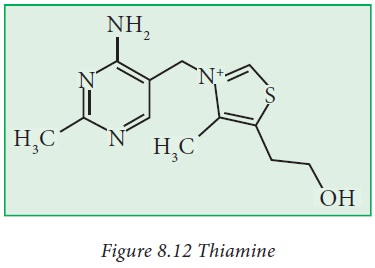
Sources:
Liver, pork,
meat, and rice are rich sources. Other good sources are beans and nuts (Figure
8.13).
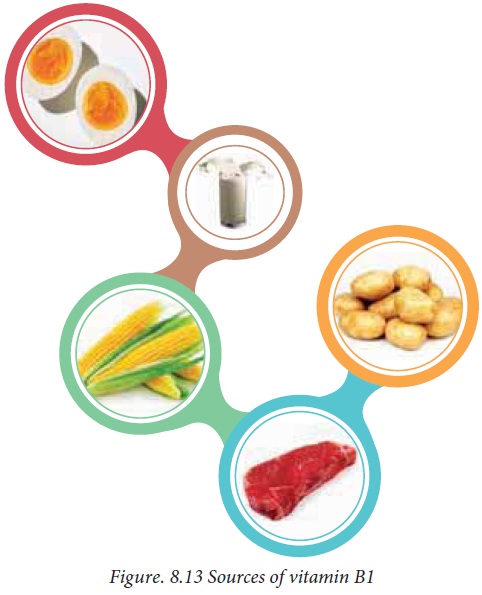
Functions:
·
Thiamine act as a coenzyme in the form of thiamine pyrophosphate (TPP)
in many enzymatic reactions. These are involved mainly in the breakdown of
glucose to yield energy.
·
Thiamine pyrophosphate (TPP) also acts as a coenzyme for transketolase
reactions in the phosphogluconate oxidative pathway of carbohydrate metabolism.
This reaction is essential for ribose formation, a constituent of DNA and RNA.
·
Vitamin B1 is also required in tryptophan metabolism for the
activity of the enzyme tryptophan pyrolase.
·
The adequate level of thiamine provides healthy nerves, a good mental
outlook, a normal appetite and digestion.
Absorption and storage:
Free
thiamine is readily absorbed by the small intestine. Thiamine is not stored in
the human body. The excess thiamine is excreted in urine and also degraded by
the enzyme thiaminase.
Deficiency:
The
symptoms of thiamine deficiency occur because the tissue cells are unable to
receive sufficient energy from glucose. Therefore, they cannot carry out their
normal functions. Early symptoms of thiamine deficiency include fatigue,
irritability, depression and numbness of the leg and poor tone of the gastrointestinal
tract together with constipation.
Beriberi
is the disease caused by thiamine deficiency. Beriberi is characterized by
oedema in the legs. Usually, beriberi is caused by carbohydrate rich and low
thiamine diets such as polished rice.
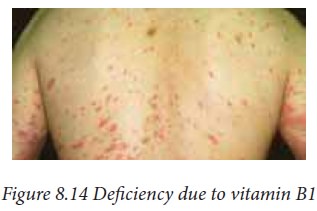
ii. Vitamin B2 (Riboflavin)
Vitamin
B2 which is also known as riboflavin consists of a heterocyclic
isoalloxazine ring attached to ribitol (a pentose alcohol). It is a yellow
coloured compound.
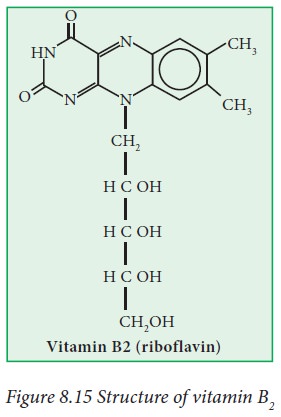
Sources:
It is
widely distributed in plants. Soy beans, green vegetables are good sources of
this vitamin. High concentration occurs in yeasts, milk and egg (Figure 8.16).
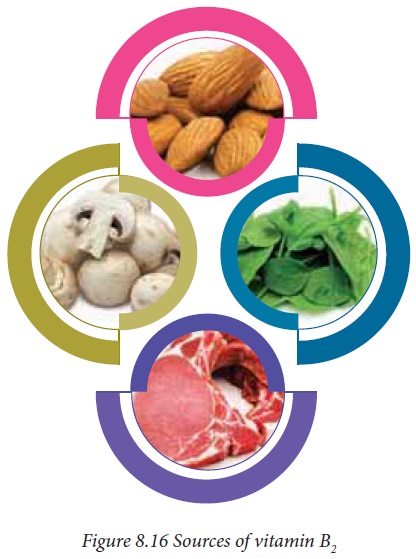
Functions:
Riboflavin
is a component of two important coenzymes, namely flavin mono nucleotide (FMN)
and flavin adenine dinucleotide (FAD). They play key roles in various enzymatic
reactions.
FMN and FAD are synthesized as follows.
Riboflavin
+ ATP → FMN +ADP
FMN +
ATP → FAD +PPi
FMN and
FAD combine with different apoenzymes to form a large number of redox enzymes.
Eg. FMN
is associated with the enzyme cytochrome c reductase.
FAD is
found in xanthine oxidase and acyl CoA dehydrogenase
Riboflavin
is essential for a healthy skin and for good vision in bright light.
Absorption and storage
The
vitamin is phosphorylated in the intestinal mucosa during absorption. It is
absorbed by the small intestine through the portal vein and is distributed to
all tissues. The major part is excreted in urine and a small part is
metabolized in the body.
Deficiency:
Riboflavin
deficiency leads to cheilosis. It is characterised by the development of
fissures developing in the lips and at the corners of the mouth.
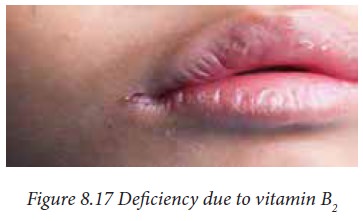
Riboflavin
is extremely sensitive to strong light. Due to sensitivity, riboflavin
deficiency may occur in new born infants with hyper bilirubinemia who are
treated by phototherapy.
iii. Vitamin B3 (Niacin)
Vitamin
B3 which is also called as niacin or nicotinic acid is pyridine
3-carboxylic acid.
It
occurs in tissues as nicotinamide (Figure 8.18).
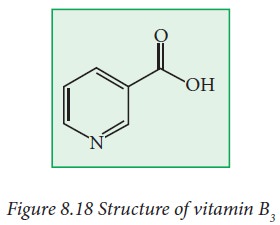
Sources:
This
vitamin is widely distributed in cereals, dark green leafy vegetables. Liver
and kidney are rich sources of this vitamin.
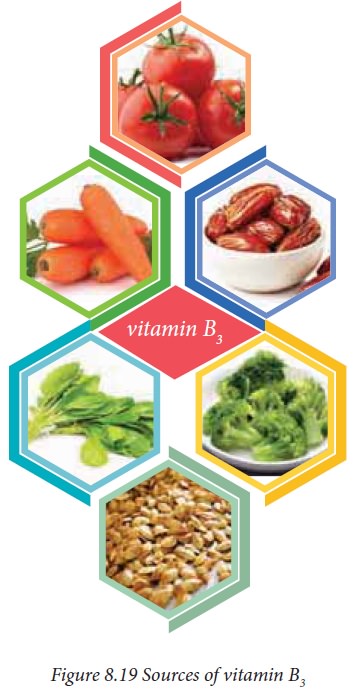
Functions:
·
Niacin is found in the form of its amide which is an important
constituent of the coenzymes NAD+ and NADP+ and they take
part in redox reactions which are associated with many dehydrogenases. For
example NAD+ is the coenzyme for lacate dehydrogenase. NADP+
is the coenzyme for glutathione reductase.
·
It promotes the formation of fat from carbohydrates.
·
Niacin is essential for healthy skin, normal functions of the gastro
intestinal tract and maintenance of the nervous system.
Absorption and storage
Nicotinic
acid and nicotinamide are absorbed by the intestine through the portal vein
into the general circulation. Excess nicotinic acid is not stored in the body.
Deficiency:
·
Nicotinic acid deficiency causes a disease called pellagra (Figure
8.20).
·
Dermatitis-skin exposed to the sun, soreness of the mouth and swelling
of the tongue.
·
Diarrhoea.
·
Dementia-mental changes including depression and confusion.
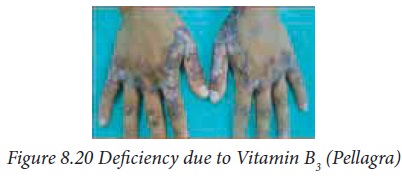
iv. Vitamin B6 (Pyridoxine)
Vitamin
B6 or Pyridoxine is also called as adermin. Vitamin B6
consists of three closely related pyridine derivatives.
·
Pyridoxine
·
Pyridoxal
·
Pyridoxal amine
The
metabolically active form of vitamin B6 is pyridoxal phosphate. It
is formed from pyridoxal.
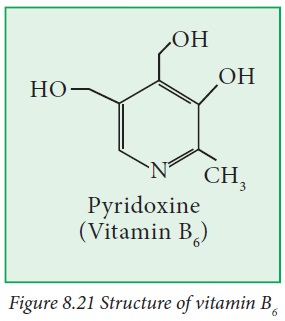
Sources:
Rich
sources of this vitamin are yeast, whole grain, cereals and egg-yolk. Moderate
amounts are present in organ meats like liver and kidney.
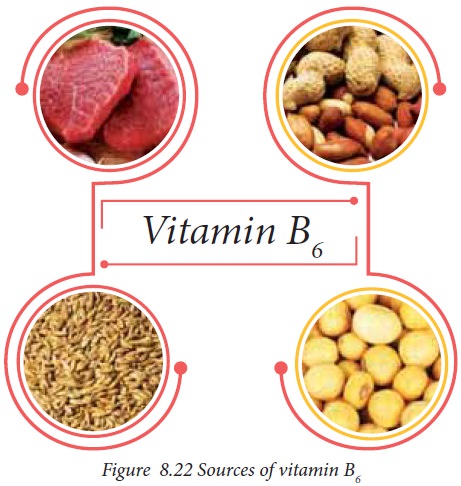
Functions:
Pyridoxal
phosphate acts as coenzyme for several enzymes of amino acid metabolism.
Example:

· It is involved in the formation of heme in hemoglobin.
· Pyridoxal phosphate acts as a coenzyme for the
decarboxylase in decarboxylation reactions.Amino acids are decarboxylated to
form their corresponding amines.

· Vitamin B6 is involved in the synthesis
of coenzyme A from pantothenic acid.
· It is also involved in the production of
antibodies.
· Pyridoxal phosphate plays a key role in
glycogenolysis.
Absorption and storage
Pyridoxine is readily absorbed by the
small intestine. The excess amount if ingested is not stored in the body, and
is excreted in urine.
Deficiency:
Deficiency
of vitamin B6 is extremely rare. In infants its deficiency causes
irritabilities, insomnia, muscular weakness and convulsion. The cause of the
convulsions are severe impairment of the activity of the enzyme glutanate
ecarboxylase, which is dependant on pyridoxal phosphate. The product of
Glutamate decarboxcylase in γ-aminobutyric acid (GABA), which is a reguletory
neurotransmitter in the central nervous system.
v. Vitamin B12:
Vitamin
B12 has complex ring structure, similar to porphyrin ring which has
a cobalt ion (Co3+) at its center (Figure. 8.23). The active
coenzyme forms of vitamin B12 are methylcobalamine and
deoxyadenolsyl cobalamine. The six co-ordination valencies of cobalt ion (Co3+)
are satisfied by the four nitrogens of reduced terapyrrole and the fifth by the
nitrogen of 5, 6 dimethyl benzimidazole moiety and the sixth one either by CN‒
(cyanocobalamine)
or H2O
(aquacobalamine) or
OH‒
(Hydroxycobalamine) or
CH3 (methylcobalamine)
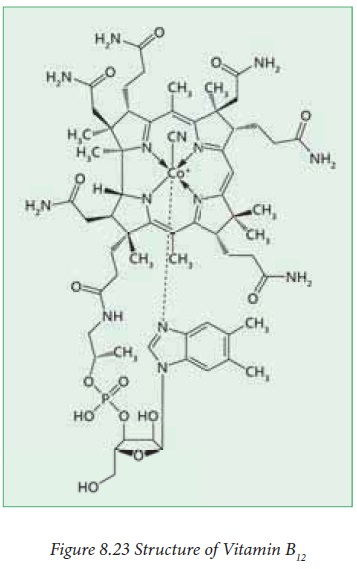
Sources:
Vitamin
B12 is found in animal but not in vegetable foods and is unique in
that it is the only known vitamin that holds an ion of metal (cobalt) in its
molecule. Eggs and meat supply ample amounts of this vitamin.
Functions:
·
Many microorganisms require vitamin B12 for growth.
·
Vitamin B12 is required as coenzyme for the conversion of
L-methylmalonyl CoA to Succinyl CoA by the enzyme methylmelonyl CoA mutase.
This reaction is essential for in the metabolisom of some branched-chain amino
acids and odd-chain fatty acids
·
Vitamin B12 is required for the maturation of red blood cells
in the bone marrow and for the synthesis of proteins.
Absorption and Storage
Vitamin
B12 is absorbed from ileum. For the absorption of vitamin B12
from the intestines, a factor called “Intrinsic Factor” (IF) secreted by the
stomach is essential. Vitamin B12 is stored in fair amounts in the
liver.
Deficiency:
When
absorption is prevented by lack of intrinsic factor, it leads to the condition
called pernicious anemia. It is characterized by a drastic decrease in red
blood cell count and leads to formation of macrocytic red blood cells.
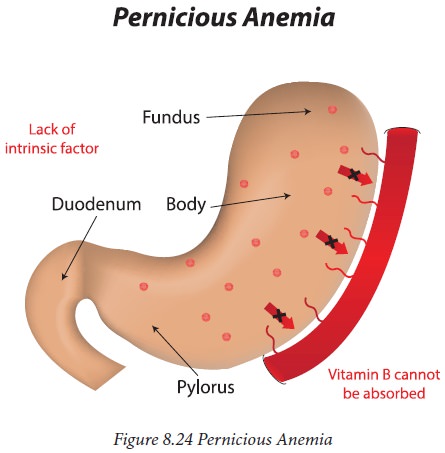
Vitamin
B12 deficiency causes an increased concentration of methyl malonic
acid, which competes with malonyl CoA and impairs fatty acid synthesis.
vi. Biotin (Vitamin B7):
Biotin
is a heterocyclic monocarboxylic acid. It is a Sulphur-containing water soluble
vitamin.
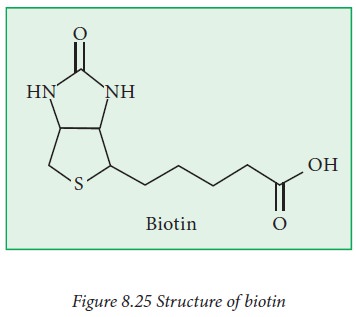
Sources:
Foods
rich in biotin are liver, kidney milk and egg-yolk. Vegetables, grains are good
sources.
Functions:
·
It is essential for the synthesis of lipids.
·
Biotin functions as the coenzyme for the enzyme called carboxylases, which
catalyzes carboxylation reactions. Eg. Acetyl CoA carboxylase converts acetyl
CoA to malonyl - CoA, which is required for fatty acid synthesis.

· It helps in the conversion of pyruvic acid to
oxaloacetic acid. The enzyme that catalyzes this reaction is pyruvate
carboxylase.
· It helps to maintain the skin and the nervous
system in good condition.
· It involves in deamination of certain amino acids
like aspartate, serine and threonine.
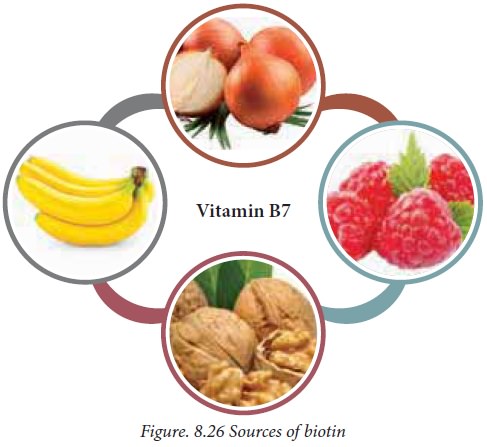
Deficiency:
Egg
white contains a protein called avidin (egg white injury factor) which binds
very tightly with biotin, preventing its absorption and thereby inducing biotin
deficiency. The symptoms include depression, hair loss and muscle pain.
vii. Folic acid (Vitamin B9):
Folic
acid otherwise known as vitamin B9, folavin or folate is essential for cell
division. Its active coenzyme is tetrahydrofolate (THF). The naturally occuring
folate is susceptible to high heat and UV light and also be subject to
oxidation.
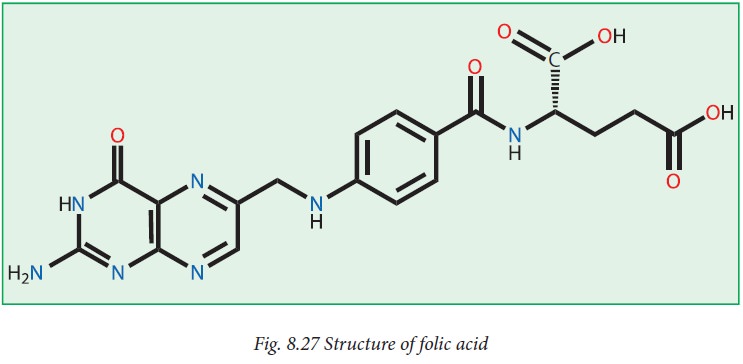
Sources
Folate naturally occurs in a wide variety of foods,
including dark green leaf vegetables, fruits, nuts,
soybeans, chickpeas, dairy products, poultry and meat, eggs, seafood, grains.
Vegetables such as avocado, beetroot, spinach, liver, yeast, asparagus, kale,
and brussels and sprouts are among the foods with the highest levels of folate.
Function
·
Folic acid is essential for cell division and growth
·
It is important for preventing birth defects.
·
It is used in the synthesis of amino acid methionine.
·
Tetrahydrofolate (THF) is needed to transfer one carbon units in the
biosynthetic reactions.
Absorption and storage
Folates
are absorbed in the small intestine. The body can store a small amount in
liver.
The
excess is removed from liver via bile.
Deficiency
Folate
deficiency signs include anemia (megaloblastic anemia) and dysfunction of the
gastrointestinal tract. The anemia is caused by the abnormal blood cell
division resulting in fewer and larger red blood cells.
Lack of
folate in the diet can cause neural tube defects in an embryo of a pregnant
woman. These can cause fatal birth defects.
viii. Pantothenic acid (Vitamin B5):
Pantothenic
acid is found in every living cell including plant, animal and microbes. It is
a part of coenzyme A which is an essential coenzyme involved in the catabolism
of carbohydrates, proteins and fat.
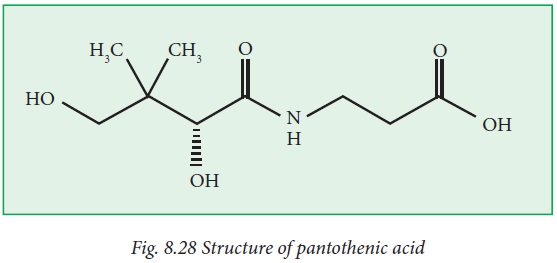
Sources
Pantothenic
acid is present in dried mushrooms, avocado, dried egg yolks and sunflower
seeds in high amounts. Outer layer of whole grains contains the vitamin, but
milling removes much of the pantothenic acid.
Function
· Pantothenic acid forms a part of coenzyme A which
is an essential coenzyme for metabolising carbohydrates, fat and proteins.
· It is necessary to synthesise vitamin D, steroid
hormones and red blood cells
· It also helps to boost the immunity
Absorption and storage
Free
pantothenic acid is absorbed into intestinal cells via a saturable,
sodium-dependent active transport system. However, in foods, most pantothenic
acid is in the form of CoA or bound to acyl carrier protein (ACP). Since the
intestinal cells can only absorb this vitamin in free pantathenic acid, it is
converted into free panthothenic acid in intestine.
Deficiency
Pantothenic
acid deficiency is very rare and seen only in cases of severe malnutrition.
Pantothenic acid is found in many common foods and average diets are thought to
have an adequate amount of it.
Vitamin C
Vitamin
C is called as ascorbic acid. Ascorbic acid is an enediol-lactone of an acid
with configuration similar to that of the sugar L-glucose.
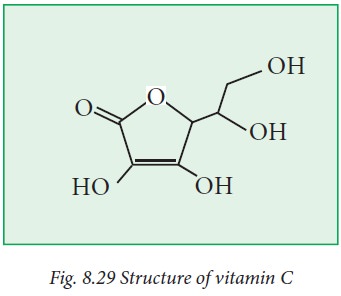
Sources:
Citrus
fruits like orange, lemon are especially rich in vitamin C. Water melons,
tomatoes, grape and leafy vegetables are also good sources.
Amla – 600-700mg/100g
Guava-
200-300mg/100g
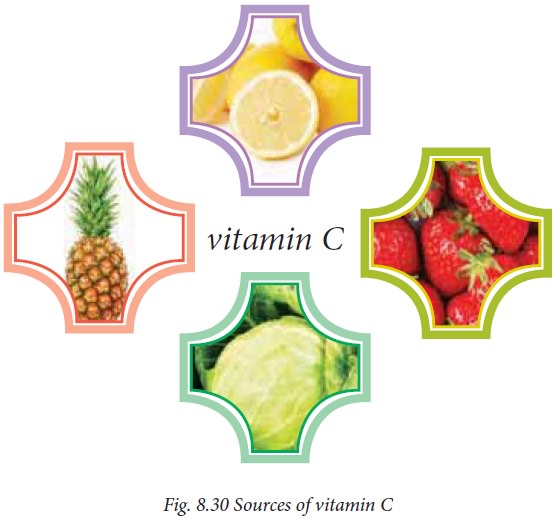
Functions:
· Vitamin C is involved in cellular
oxidation-reduction reactions inside the cell as hydrogen carrier.

· Vitamin C is essential for building collagen, the
connective tissue protein which cements the cells and tissues together.
· It regulates carbohydrate metabolism.
· Vitamin C is required as coenzyme for the enzyme
dopamine hydroxylase which catalyzes the conversion of dopamine to
nor-epinephrine.
· It is involved in the maturation of red blood
cells.
· The absorption of iron is significantly enhanced by
the presence of vitamin C.
· It has a general antioxidant role , especially in
the regeneration of oxidized vitamin E in membranes.
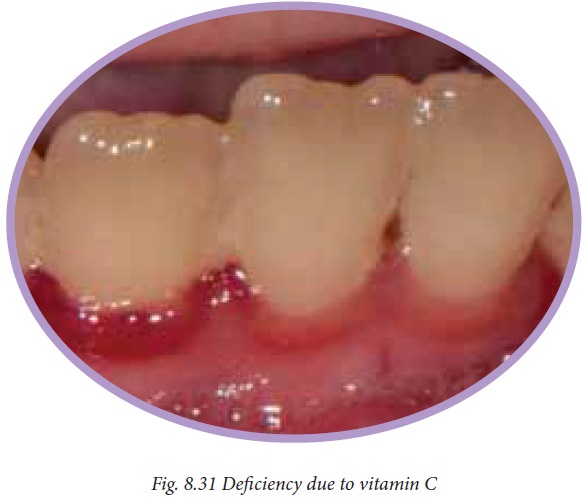
Absorption and storage
Ascorbic
acid is rapidly absorbed from the intestines and passed on through the portal
vein to the general circulation. Vitamin C is found in highest concentrations
in the adrenals, the pituitary and retina than in circulation. Excessive intake
of the vitamin do not increase beyond the optimal levels.
Deficiency:
Scurvy is the classical syndrome of
vitamin C deficiency. It is related to defective collagen synthesis which is
indicated by fragile skin, muscle weakness, bleeding of the gums, loose teeth
and delayed wound healing.
Table 8.1. Recommended Daily
Allowances(RDA) of fat and water soluble vitamins for Adults
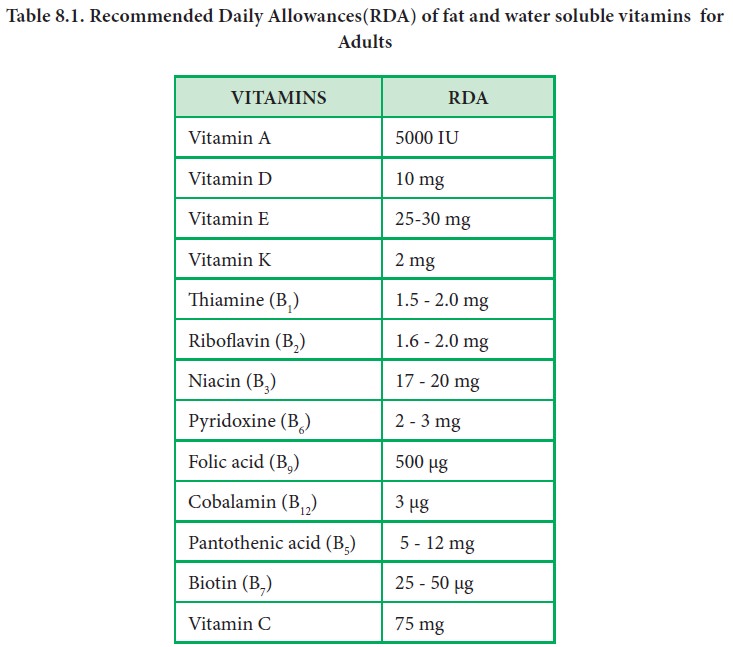
Related Topics